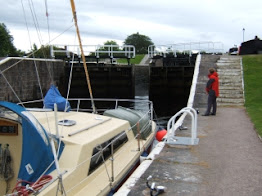Somewhere back in the mists of time maybe when Britain was covered by ice sheets miles thick or then again perhaps even earlier, tectonic movements in the earth's crust did their level best to tear apart what was later to become Scotland, to divide it into two sections so that when in time the water flowed into the North Sea and created the island we now call Britain, the northern part of Scotland might have itself become a separate island. The tectonics narrowly failed but what they left behind was a divide across Scotland, cut deep as if with a giant axe. Where the blade buried deepest has now filled with water so deep that its depths lie lower than the lowest part of the North Sea itself, a dark water stained heavily with peat from the slopes falling into it. Loch Ness, as this water is called, is deeper than any water on the continental shelf upon which Britain floats, contains more water than every English and Welsh lake combined and is the largest volume of fresh water in the whole British Isles.
Such statistics are truly sobering here on Cirrus, moored on its surface as night falls. The steep sides of the Great Glen divert sudden gusts of wind down on us from the mountains around (sailors call these 'williwaws') although we are safe enough tucked into a little cove nearly half way along the loch's 26 miles length and surrounded by a tree-lined shore.
Our first view of the Great Glen came as we sailed west out of the Moray Firth towards Inverness.
Mysteriously it was as if the sky also divided, reflecting the land beneath. Our boat then had to raise itself to the level of Loch Ness through a series of locks, one a flight of four coupled together, great edifices of stone designed by Thomas Telford who also had a hand in many of the harbours we have been visiting over the last few weeks.
Finally the loch itself stretched before us and the bottom sloped away. It was raining, of course, but then the water has to come from somewhere, I suppose.
All this contrasts strongly with the tiny Angus, Argyll and Moray harbours we have been popping into each night as we made our way along the coast, friendly places where everyone passing calls a greeting and the stranger is made to feel welcome. These places are built so that waves can sweep in only with difficulty. Invariably this means turning a sharp corner just as you enter and the harbour is hidden from view until the last moment. The inner harbour is always a surprise, usually pleasant, but in Banff we had an encounter rather more surprising than most. For just beyond the narrow entrance we encountered a JCB digger, a first for us, up to its knees (crawler tracks) in the water dredging sand from the bottom. After a friendly wave from the driver we motored cautiously past to take up a pontoon berth just beyond.
Where, you might ask, are the photos of this encounter. And likewise where are the photos of the dolphins which swam towards us as we approached and left Burghead harbour, big beasts coming close enough to look us straight in the eye from just beneath our bow.
Sadly on this occasion we missed these opportunities so your imagination will have to fill in for you.




No comments:
Post a Comment